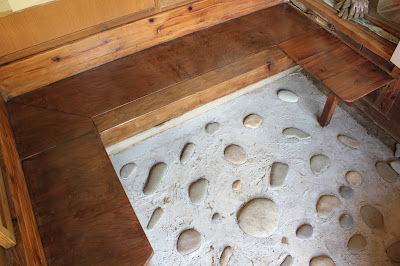Honestly when we arrived at Obachan's ready to transform this little farmhouse, it was looking a bit ghostly with all the old torn shoji screens.
It would be some time before we could begin to think about replacing the paper. As you know there were more pressing projects to get onto, but sleeping with these screens surrounding us was a little depressing, but our patience has paid off. The shoji screens would have their day!
So first, we used a spray bottle filled with water and drenched the paper to loosen the old glue.
Then the fun part...peeling the old paper slowly away from the frame.
Now the not so fun part, scrubbing the old glue from the wooden frame. Guess how many screens we had to scrub? In total 10!!! After this we were on a bit of an assembly line helping each other to replace the old tape both vertically and horizontally.
Yeah, it was time consuming! We pushed ourselves to get the screens done by working into the early hours of the morning.
We did our research before ordering rolls of shoji paper. What we found is that there are many different types, patterns, durability and of course the price to consider for shoji paper. In the end we opted for a plain white sheet that is plastic is texture, but looks like paper.We also chose the tape, rather than using glue or the new fad of ironing it on. The reason we went for the plastic form is that the genkan gets a lot of traffic in and out of the house and it would also be easier to clean when little creatures ran over it. And lets be honest, this is the countryside and its a very old little house, so dirt and dust is inevitable.
Once we laid out the paper there was some adjustments to be done, so we simply cut the excess off. As I said before, we worked on ten shoji screens but this is what we ended up with...looks good right!
We couldn't be happier with the end result. I personally love the "bones" of the frame to show outwards to the street, but traditionally it is the flat paper that should be shown. Either way we are loving it!
Our local onsen has been closed for maintenance for more that a month, but it has since re-opened. Personally, we love our local onsen instead of making the journey to the next town. So, after all the scrubbing of old glue from the frames, peeling of old smelly paper and endless taping its time for another onsen!







































